Network and Data Communication cha3-4
Cprogramming
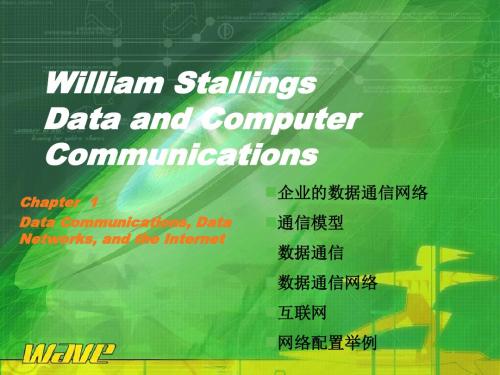
通信主要任务
寻址
当传输设施被两个以上设备共享时,信源必须给出信 宿的标识
路由选择
当传输系统是不只一条路径的网络时需要确定路由
恢复
信息交换过程中因通信系统某处出现故障而致使传输 中断,需要从中断处恢复工作,或者把系统被涉及部 分恢复到数据交换开始之前的状态
报文格式化
数据交换双方必须就传输的数据格式达成一致协议 交换代码转换、压缩、加密
g(t) s(t)
信源
发送设备
传输系统
r(t)
接收设备
g’(t)
信宿
n(t)
噪声
DTE与DCE
数据通信系统中,发送端信源和接收端的信宿称为 DTE(数据终端设备,Data Terminal Equipment),如计 算机之类的终端设备。 发送和接收设备称为DCE (数据电路端接设备, Data Circuit Terminating Equipment)。DCE有时也称作数 据通信设备(Data Communication Equipment)。
5
Destination(信宿) Takes incoming data
各个组成部分的说明
信宿:信息传输的目的地,即接收消息的人或机器。 传输系统:即信道,也是传递物理信号的媒体。信道可 接收设备:其作用主要是接收信道中的信号,并转换成 信源:顾名思义,指信息产生的源头,可以是人或设备。 发送设备:种类及其功能多样化,如编码、调制、放大、 噪声源:是整个系统噪声与干扰的总折合,用以表征信 以是明线、电缆、波导、光纤、无线电波等。 发送前相同表示形式的信息传递给信宿,与发送器功能 其发出的信息也可以是多种多样的,如语音、文字、图 滤波、发射等。发送器含有与传输线路匹配的接口,其 息在信道中传输时遭受的干扰情况。在任何通信系统中, 像、数据等。这些信息可以是离散的,也可以是连续的。 正好相反。对接收器的要求是尽可能地从受干扰的信号 基本作用是将信源发出的信息转换成便于传输的某种信 干扰的性质与强弱都是影响系统性能的重要因素。噪声 中精确地提取和还原来自信源的信息。 号。模拟与数字通信系统两者的发送器功能有很大差异。 的干扰实际存在于整个通信系统中,为便于分析,并考 虑到信道上的干扰最为严重,故通信模型把噪声干扰集 中在信道上表示为n(t)。
无线自组传感器网络中基于能量的超宽带多路径路由算法英文
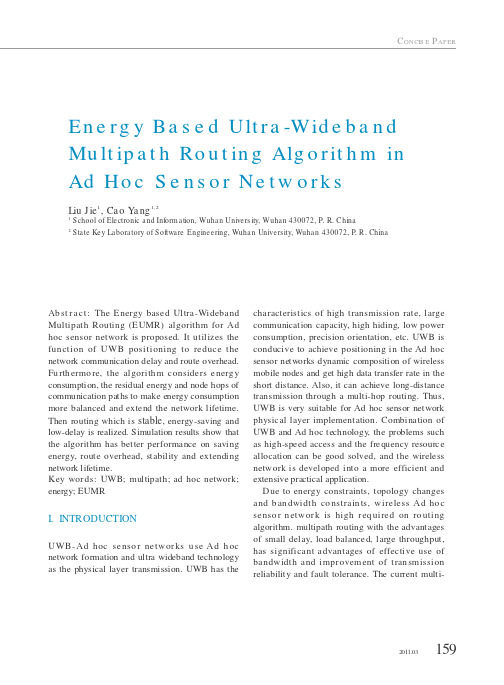
短文En e r g y B a s e d Ult r a-Wid e b a n dMu lt ip a t h Ro u t in g Alg o r it h m inAd Ho c S e n s o r Ne t w o r k sLiu Jie1,Ca o Y a ng1,21School of Electronic and Information,Wuhan Univers ity,Wuhan430072,P.R.China2State Key Laboratory of Software Engineering,Wuhan University,Wuhan430072,P.R.ChinaAb st r act:The Energy based Ultra-Wideband Multipath Routing(EUMR)algorithm for Ad hoc sensor network is proposed.It utilizes the fun ction of UWB positioning to reduce the network communication delay and route overhead. Fu rth ermo re,the algorith m considers energ y consumption,the residual energy and node hops of communication paths to make energy consumption more balanced and extend the network lifetime. Then routing which is stable,energy-saving and low-delay is realized.Simulation results show that the algorithm has better performance on saving energy,route overhead,stability and extending network lifetime.Key wor ds:UWB;multipath;ad hoc network; energy;EUMRI.INTRODUCTIONUWB-Ad hoc senso r networ ks u se Ad h oc network formation and ultra wideband technology as the physical layer transmission.UWB has the characteristics of high transmission rate,large communication capacity,high hiding,low power consumption,precision orientation,etc.UWB is conducive to achieve positioning in the Ad hoc sensor networks dynamic composition of wireless mobile nodes and get high data transfer rate in the short distance.Also,it can achieve long-distance transmission through a multi-hop routing.Thus, UWB is very suitable for Ad hoc sensor network physical layer bination of UWB and Ad hoc technology,the problems such as high-speed access and the frequency resource allocation can be good solved,and the wireless network is developed into a more efficient and extensive practical application.Due to energy constraints,topology changes and b an dwidth co nstrain ts,wireless Ad ho c senso r n etwor k is high r eq uired on ro uting algorithm.multipath routing with the advantagesof small delay,load balanced,large throughput, has significant advantages of effective use of bandwidth and impr ovem ent of tran sm ission reliability and fault tolerance.The current multi-2011.01935path routing protocols mainly are SPIN,DD[1], SAR,TORA,SMR[2],MSR,etc.At present, energy-based multi-path routing protocols are less and representative routing protocols mainly have EAR[3],MMER[4]and so on.In Ref.[3], energy multi-path routing protocol EAR proposed by Shah RC et al sets up multiple paths between source nodes and destination nodes.As the node chose probability is energy related,the energy consumption of communication is distributed to multiple paths,so data transfer balanced consume the energy of the whole network and the network lifetime is extended.EAR protocol can achieve balanced energy consumption in the network to maximum prolong the network lifetime.In Ref.[4],accor ding to the mode of disjoint m ulti-path data tr an smissio n,MMER pr otoco l is designed by the global energy minimization of the routing mechanism to achieve balanced energy consumption and energy ef ciency.In order to reduce energy consumption,reduce routing load,balance energy consumption of the network and extend the network lifetime,based on EAR protocol proposed by Shah RC et al, a scheme called energy based ultra-wideband multipath routing(EUMR)is proposed.The results show that EUMR can balanced consume energy of the network,reduce the transmission delay,extend the network lifetime and reduce the impact on the routing algorithm due to network changes.II.EUMR ALGORITHMA.Basic Idea of EUMR Algor ithmTh e nodes nu mber and data r ed undancy are much more in Ad hoc network.In order to reduce energy consumption and to ensure reliability of data transmission,EUMR consider s energy consumption,the residual energy and node hops of communication paths to make energy consumption more balanced and extend the network lifetime. UWB-Ad h oc senso r n etwo rk usin g UWB tech nolo gy of MAC,UWB techno logy can provide accurate positioning information for the upper layer.This feature will be applied to EUMR algorithm.(1)As data is to be sent,according to UWB positioning message,if destination node is in the range of a hop of the node,source node direct sends data packet without broadcasting path setup massage by destination node.(2)In route setup process,if the intermediate node want to send path setup message,it judges whether the target node in its a hop communication range.If in the range, the target node is directly added to the self route recording table,without broadcasting the message. Using the UWB positioning function,through there is only one hop,several network load can be reduced.B.Descr iption of EUMR AlgorithmIn UWB-Ad hoc sensor network,we suppose:sN is source node;DN is the destination node;()iCost Nis the communication cost of nodeiN reaching the destination node D N.Route setup:The important step of EUMR algorithm is route setup.Every node needs to know all the next hop nodes which can reach the destination node and calculate probability of choosing each next hop node.The process of route setup includes the following steps:(1)Destination node constructs a path setup m ess ag e and br oadcas ts the message to all neighbor nodes.The path setup message has the following format:interest=(type,interval,rect, timeamp,expiresat,cost).The end of data packet of path setup message contains a cost domain, which express the cost of nodes communication.The initial value is0,()0DCost N=.(2)The path setup message is sent between intermediate nodes.Every intermediate n ode f orwards the path setup message o nly to the neighbors that closer to the sour ce node than oneself and farther away from the destination node. Thus at the node i N,the message is sent only to a neighbor node j N,which satis es:(,)(,)i s j sd N N d N N≥102011.06336短文2011.011EUMR:Not only the hops constraint is added, but also route load is optimized by using UWB positioning message.In EUMR-1,the hops value is contained in path setup message,thus it is propitious to choose path with less hops.Also,the hops value is taken into account in calculating chose probability of the next hop,thus in the case of the same energy consumption of the nodes,according to choose the path with less hops,data packet communication delay can be reduced to improve communication ef ciency.In EUMR-2,node is judged whether in the range of communication by using UWB positioning message,through there is only one hop.Thus several load of network can be reduced.EUMR utilizes orientation identity of UWB to reduce the network communication delay and route cost.Furthermore,the routing algorithm considers energy consumption,the residual energy and node hops of communication paths to make energy consumption more balanced and extend the network lifetime.Then energy-saving and low-delay routing was realized.Based on EAR protocol proposed by Shah RC et al,EUMR algorithm is proposed.The routing algorithm utilizes the function of UWB positioning to reduce the network communication delay and route cost.Furthermore,it considers energy consumption,the residual energy and node hops of communication paths to make energy consum ption mor e balanced and exten d the network lifetime.Then routing which is stable, energy-saving and low-delay is realized.III.S IMUL AT IO N R E S ULT S AN D ANALYSISA.Simulation Environment and Par ameter Setting Using NS2simulation platform,the relev ant simulation parameters are as follows:Table I Simulation parameter settingsimulation parameter valuethe size of network area(m2)1000×1000channel bandwidth(Mbps)500(UWB) wireless transmission distance(m)100MAC protocol TDMA the nodes number of network30the initial energy of node(J)5packet generation rate(s)0.001mobile model Random Waypoint node movement intervals(s)10 the average velocity of node(m/s)(0,30)simulation time(min)80α,β,A,B1,50,0.5,0.5B.Per for m ance Standar dEUMR algorithm is on-demand routing algorithm. SMR protocol is a typical on-demand routing protocol with good performance.Many multipath routing protocols,such as MSR,TORA,all adopt a similar route setup mechanism as SMR.EUMR is compared with classic on-demand routing protocol SMR,we analyze performance of routing algorithm on packet delivery rate,average delay,routing overhead,the number of dead nodes, the network lifetime.(1)Packet delivery rate:It is the ratio of the number of data packets received by destination node and the number of packets sent by source node.The higher packet delivery rate is,the less lost packets in the transmission process are and the better performance of the network is.(2)Average end-to-end delay:It is an average difference between the packets received time of destination node and the packets transmitted time of source node.The smaller delay is,the faster response is,and the better performance of the network is[7].(3)Norm alized routin g overhead:It is the ratio of the number of control packets sent by all nodes and the number of total sent packets. This parameter reflects the stability of path in dynamic environment,the smaller the overhead is,and the more stable the path is.122011.063363短文(4)The number of dead nodes:It is the number of nodes,of which the energy is reduced to zero.(5)Network lifetim e:I t is the time when the first node appears in the network.This parameter reflects the overall vitality of the net work.In general,t he longer the node lifetime i s,the network energy balanced consumption will be better controlled [8].C.Analysis of SimulationResultsFig.1Packet delivery rateIt can be observed in the gure that when the network is stabile (for node speed smaller),the packet delivery ratio EUMR and SMR are both high.With the increase of node mobile speed,SMR takes more time for route setup and the lost packets are also more.Thus,the packet delivery rate of SMR protocol decreases significantly.However,the packet delivery rate of EUMR with slow decreased trend is much higher than SMR.In addition,as the character istics of UWB positioning can only provide information in one hop,the network performance is limited improved for EUMR-2,and EUMR-2is not more apparent than EUMR-1.It is suggested that it needs to further excavate thepotential of UWB to improve the performance ofnetwork.Fig.2A verage end-to-end delayFigure 2shows the comparisons of average end-to-end delay changing with node mobile speed.It can be seen that when the node mobile speed is small and the network is stable,the average end-to-end delay of SMR protocol is less than EUMR.The delay of SMR and EUMR increase withnode mobile speed increasing.In general,because EUMR chooses the path with smaller hops inthe case of equal energy consumption and utilizes UWB positioning function to reduce certain data packet transmission delay to improve communication efciency.Fig.3Normalized routing overhead2011.0163Figure 3shows the comparisons of normalized routin g over head changing with node mobile speed.In the results,routing overhead of EUMR is the lowest and routing overhead of SMR is the highest.When node does not move,although SMR discards duplicate request packets,as EUMRutilizes UWB positioning message and path setup message packet is not needed to sent for data communication in the range of one hop,route load is decreased.Also,path setup message can decrease a hop of broadcast,and routing overhead is effectively limited.Due to EUMR-2have no constraint on hop,routing overhead of EUMR-2is less than SMR and more than EUMR-1.As EUMR combines the optimization of EUMR-1and EUMR-2,routing overhead of EUMR is lowest.As the node mobilespeed increases,the routing overhead of SMR and EUMR both increase,EUMR algorithm has obviousadvantages.Fig.4The number of dead nodesFigure 4shows the number of dead n odes changing with node mobile speed.With node mobile speed increasing,the numbers of dead nodes increase.Because EUMR-1and EUMR-2consider energy consumption rate and more efficient consume the energy of node,the dead nodes number of EUMR-1or EUMR-2is less than SMR.The dead nodes numbers of EUMR-1,EUMR-2and EUMR are close to each other,as the node move randomly lead to predictionsinaccurate.Fig.5The network lifetimeFigure 5shows the network lifetime changing with node mobile speed.With node mobile speed increasing,the network lifetime decrease.Mainly because the network topology changes increase and control overhead increases with nodes mobile speed incr easing,the network lif etime arrive in advance.The network lifetime of EUMR-1,EUMR-2or EUMR is longer than SMR.IV .CONCLUSIONSIn order to reduce energy consumption,ensure reliability of data transmission and improve network performance,EUMR algor ithm is proposed.The routing algorithm utilizes thef unction of UW B po sitio ning to r ed uce th e network communication delay and route overhead.It considers energy consumption,the r esidual energy and node hops of communication paths and calculate probability of choosing each next hop node on communication paths.The results show that by choosing stable ,energ y-sav ing an d low-delay routing basedon UWB positioning function and energy,EUMR can balan ced co ns um e th e en erg y of network,r edu ce the transm ission delay ,extend the network lifetime and improve the performance of network.142011.0短文References[1]INT ANAGONWIW AT C,GOVINDAN R,ESTRIN D,etal.Directed Diffusion for Wireless Sensor Networking[J].IEEE/ACM working,2003,11(1):2–16.[2]LEE S J,GERLA M.Split Multipath Routing withMaximally Disjoint Paths in Ad hoc Networks[R].IEEE ICC2001,Helsinki,2001:3201–3205.[3]SHAH R C,RABAEY J M.Energy Aware Routing forLow Energy Ad Hoc Sensor Networks[C]//Proceedings of IEEE Wireless Communications and Networking Conference.Piscataway,USA,2002:17–21.[4]YIN Shouyi,LIN Xiaocang.Multipath Minimum EnergyRouting in Ad Hoc[R].IEEE International Conference, 2005:3182–3186.[5]INTANAGONWIWAT C,GOVINDAN R,ESTRIND.D irect ed Di ffus ion:A Scalab le and Rob us tCommunication Paradigm for Sensor Networks[C]// Proceedings of ACM MobiCom2000,Boston,MA,2000: 56–67.[6]WANG Quandi,LI Bing,LIU Qingsong.Research onenergy Multipath Routing for Wireless Sensor Network[J].Information and Control,2006,35(2):130–132.[7]H EI NZ E LM AN W R,CHA N D RAK A SA N A,BALAKRISHNAN H.Energy-Efficient Communication Protocol for Wireless Mi crosensor N etwo rks[C]//Proceedings of the33rd Hawaii International Conferenceon System Sciences,2000:1–10.[8]MANN R P,NAMUDURI K,PENDSE R.Energy AwareRouting Protocol(EARP)for Ad-Hoc Wireless SensorNetworks[C]//Proceedings of IEEE CommunicationsSociety Globe com2004Workshops,2004:419–427. BiographiesLiu J ie,received h er Mas ter degree ofCommunication and Information System in July2006at Wuhan University of technology.She iscurrently PhD candidate at School of Electronic and Information,Wuhan University.Her research interests includes UWB wireless communication and wireless sensor networks.E-mail:LJ_IVY@Cao Y an g,received his Bachelor degree ofElectronic Engineering in1967at HuazhongUniversity of Science and Technology.He iscurrently a professor at School of Electronic and Information,Wuhan University.He is also an assistant directorof Information Network Technology Committee in China Institute of Communication,China.His research interests the next Generation internet and security,wireless sensor networks and applications,the design theory and methods of Soc.E-mail:caoyang@2011.01365。
数据与计算机通信(英文) 教学大纲

数据与计算机通信(英文)一、课程说明课程编号:090326Z10课程名称:数据与计算机通信(英文)/Data and Computer Communications课程类别:专业教育课程学时/学分:32 / 2先修课程:高等数学、模拟电子技术、数字电子技术、信号与系统、通信原理适用专业:通信工程、电子信息工程教材、教学参考书:1.Behrouz A. Forouzan, Data Communications and Networking, 5th,McGraw-Hill, 20122.William Stallings. Data and Computer Communications, 9thEdition.Prentice Hall, 2010.3.Fred Halsall. Data Communications, Computer Networks and OpenSystems, 4th Edition. Addison-Wesley, 1996.4.David Salomon. Coding for Data and Computer Communications.Springer, 2005.5.Richard Stevens . Unix Network Programming - V olume 1 (2003) andV olume 2 (1999). Prentice Hall二、课程设置的目的意义《数据与计算机通信》课程是通信工程专业的一门选修的专业基础课。
课堂采用双语教学,使用经典的原版教材。
本课程的主要任务是从数据通信、计算机网络通信的视角来理解、分析、设计分布式的通信系统,使学生了解和掌握数据通信、计算机通信区别传统电信等语音业务承载网络的原理、技术等。
系统掌握数据通信所采用的技术,同时提高英语的阅读和理解能力。
三、课程的基本要求知识:理解数据通信的基本原理;熟练掌握数据通信、计算机通信所涉及的硬件、软件相关技术;理解计算机通信与传统电信等语音业务承载网络的区别;掌握原理计算机通信的原理;掌握科学研究的基本思路和方法,能力:掌握数据通信、计算机通信网的开发设计方法,将其用于解决实际的数据网络通信问题;熟练掌握网络编程的技能;针对数据通信新技术发展前沿问题,掌握英文科技文献综述的能力;在讨论中培养创新意识和国际前沿研究视野,培养追踪数据与计算机通信网的新技术前沿问题的能力,素质:建立原理-分析-综述-设计一体的观念,通过课程学习中的分析、讨论、辩论培养分析沟通交流素质,建立从原理分析到编程设计到实际应用的思维模式,提升发现问题、寻找解决问题方法的基本素质。
【数据通信与网络】Lecture2-SignalsAndSignalAnalysis
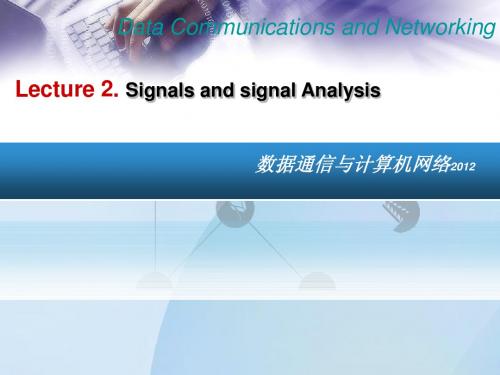
● Example 2: Time-domain plot for harmonic frequency signals
Data communications and networking
Frequency-spectrum plot for signal with the fundamental , 3rd and 5th harmonic frequency signals
Mathematical tool: integral transform, convolution(卷积) r(t) = e(t)﹡h(t) e(t)----impulse function h(t)----impulse response function Representation: time-domain plot 图 (waveform plot ) Time-domain plot shows changing of signal amplitude with time.
Important conclusion:
Periodic signal has discrete frequency-spectrum. Single impulse has continuous frequency-spectrum and its Significant bandwidth (有效带宽) is 1 /τ
Data communications and networking
Time-domain analysis
•
Any composite signal can be represented as a sum of simple sine waves
Data communications and networking
DataCommunicationsandNetworking.ppt
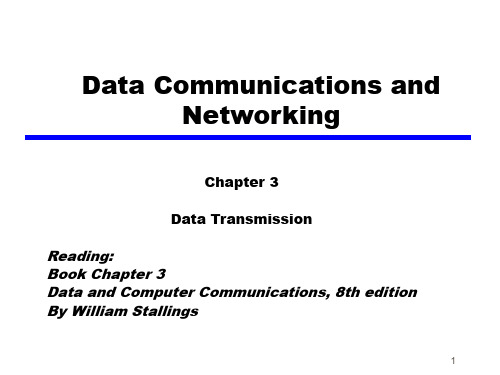
— More than two devices share the same medium Multipoint
7
Terminology (3)
• Simplex transmission
—Signals are transmitted in only one direction
1
Outline
• Concepts and Terminology • Analog and Digital Data Transmission • Transmission Impairments • Channel Capacity
2
Part 1: Concepts and Terminology
of frequency. • Time domain concepts: an electromagnetic signal can be either analog or
• e.g. Television
• Half duplex
—Signals can be transmitted in either direction, but only one way at a time.
• e.g. police radio
• Full duplex
—Both stations may transmit simultaneously.
— Note that it can apply to both guided and unguided media
• A transmission medium is point-to-point if: Point-to-point — Direct link — Only 2 devices share the medium
Digital Communications and Networks
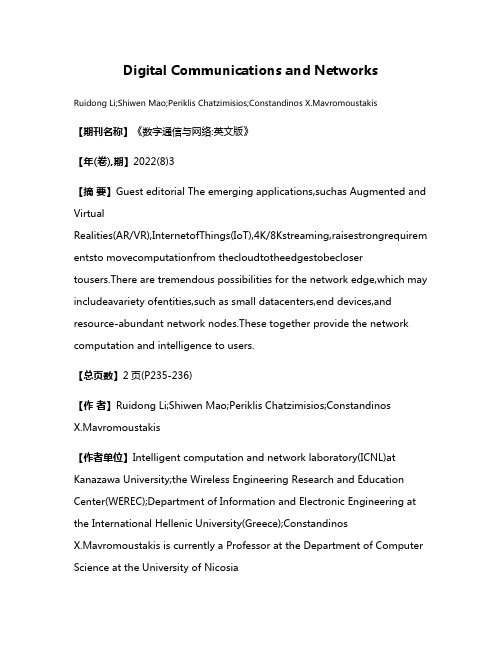
Digital Communications and NetworksRuidong Li;Shiwen Mao;Periklis Chatzimisios;Constandinos X.Mavromoustakis【期刊名称】《数字通信与网络:英文版》【年(卷),期】2022(8)3【摘要】Guest editorial The emerging applications,suchas Augmented and VirtualRealities(AR/VR),InternetofThings(IoT),4K/8Kstreaming,raisestrongrequirem entsto movecomputationfrom thecloudtotheedgestobeclosertousers.There are tremendous possibilities for the network edge,which may includeavariety ofentities,such as small datacenters,end devices,and resource-abundant network nodes.These together provide the network computation and intelligence to users.【总页数】2页(P235-236)【作者】Ruidong Li;Shiwen Mao;Periklis Chatzimisios;ConstandinosX.Mavromoustakis【作者单位】Intelligent computation and network laboratory(ICNL)at Kanazawa University;the Wireless Engineering Research and Education Center(WEREC);Department of Information and Electronic Engineering at the International Hellenic University(Greece);ConstandinosX.Mavromoustakis is currently a Professor at the Department of Computer Science at the University of Nicosia【正文语种】中文【中图分类】TN9【相关文献】1.Digital Communications and Networks Call for Papers for Special Issue on"The Security, Privacy, and Digital Forensics ot Mobile Networks and Mobile Cloud"2.Dital Communications and Networks Call for Papers for Special Issue on "The Security, Privacy, and Digital Forensics of Mobile Networks and Mobile Cloud"3.Elsevier Journal on Digital Communications and Networks Special Issue on Evolution of Information and Communication Technology towards 5G: New Emerging Areas, Technologies, Protocols and Applications4.Digital Communications and Networks Special issue on Next Generation Wireiess Communication Technologies5.Digital Communications and Networks(DCN)Editorial Board因版权原因,仅展示原文概要,查看原文内容请购买。
东北大学本科课程基本信息(B)

课程基本信息东北大学课程编号课程名称学期学时原课程编号英文名学分理论学时B070110100方法论①24070100581Methodology 11.520B070110110方法论②32070100582Methodology 2232B070120100信号与系统*64070100060Signals & Commu45648070100160Digital Signal 332B070120200数字信号处理基础B070120210数字信号处理*64Digital Signal 452B070120300微机原理与应用*48070300010Computer Princi340B070120400单片机原理及应用56070100120SCM Theory & Ap3.540B070120500可编程逻辑器件E48070100390Programmable Lo332B070120600嵌入式系统技术*48070100680Embedded System340B070120610嵌入式系统技术*64070100680Embedded System448B070130100生物医学电子学48070100170Biomedical Elec33264Biomedical Elec448B070130110生物医学电子学及B070130200生物医学仪器64070100200Biomedical equi432B070140100生产实习64070100540Industrial Inte464B070140200毕业实习16070100550Graduation Prac116B070140300毕业设计(论文)240070100560Graduation Desi15240B070140400电工电子实训32Electronics Pra2056070100495Design Centered3.50B070140500以项目为中心的课56070100494Design Centered3.50B070140600以项目为中心的课B070200020计算机图形学64070100220Computer Graphi432B070200040医学成像技术及系64070100231Medical Image T432B070200050数字图像处理与分64070100250Computer Image 432B070200070影像诊断学48070100661Image Diagnosis332B070200090Matlab32070100690Matlab216B070200110Mathematica语言32070100740Mathematica20B070200111Mathematica语言32070100741Mathematica216B070200120多尺度图像分析32070200141Multi-scale Ima216B070200130影像诊断学32Image Diagnosis232B070200140生产实习64070100540Industrial Prac464B070200150毕业实习16070100550Graduation Inte116B070200160毕业设计(论文)240070100560Graduation Proj15240B070200170以项目为中心的课56070100492Design Centered3.5056070100495Design Centered3.50B070200180以项目为中心的课48Computer Graphi332B070200220计算机图形学和可B070200240C++暑期实训48C++ Programming336B070200250嵌入式暑期实训64Embedded System43624070100010Introduction to1.524B070210200专业概论与职业发B070230110医学影像研究*64Study on Medica448B070300010生产实习64070100540Industrial Inte40B070300020毕业实习16070100550Graduation Inte10240070100560Graduation Proj150B070300030毕业设计(论文)B070300040以项目为中心的课56070100493Design Centered3.50B070311010人体解剖学*64070100030Human Anatomy43280070100610Human Anatomy &548B070311020人体解剖与生理学B070312010病理生理学*48070300030Pathophysiology332B070313010分子生物学32070100280Molecular Biolo220B070321010计算机引论(1)*64070100020Introduction to432B070321020高级语言程序设计64070300021Advanced Progra436B070321040java语言48070100150Java324B070321060C++程序设计*64070200010C++ Programming432B070322010数据结构*48070100720Data Structure332B070322020数据库原理*48070100410Database Princi340B070322050计算机网络48070100400Computer Networ33264070100100Assembly Langua440B070322060汇编语言程序设计B070322070软件工程48070300020Software Engine340 B070322080操作系统*48Operation Syste340 B070322090通讯与网络*48Communications 340 B070331010医学信息学32070100620Medical Informa220 B070331020医学信息学32070100260Medical Informa232 B070332010生物信息学32070100330Bioinformatics2032070100361Bioinformatics 216 B070332020生物信息与建模(B070333010项目管理16070100490Project managem116 B070333020商务管理16Business manage116 B070342010C语言程序实践32 C Programming P20 B070400021专业英语(1)32070100513Applied technic232 B070400022专业英语(2)32070100521Applied technic232 B070400041强化英语(1)48070100522Intensive Engli348 B070400042强化英语(2)48070100523Intensive Engli34856070100491Design Centered3.50 B070400050以项目为中心的课B070400060大学日语32College Japanes232 B070400070大学韩语32College Korean232 B070400080欧美文化32European & Amer23232European & Amer232 B070400090创新创业知识与技B080110180离散数学64080101251Discrete Mathem46424080101120Specialty Outli1.524 B080131130专业概论与职业发B080132180计算机引论(C语64080100021Introduciton to448 B080132250计算机编程导论40080101262Introduction to2.52448080100972Object-Oriented332 B080132360面向对象程序设计40Mainframe Datab2.532 B080132450主机数据库管理系B080133140通信概论32080100410Communication O232 B080134180电子技术基础64Fundamentals of448 B080141180数据结构64080100081Data Structure456 B080141250数据库系统40080101022Database System2.540 B080141350计算机网络40080101042Computer Networ2.540 B080141480软件工程64080101051Software Engine440 B080141550操作系统40080100200Operating Syste2.532 B080141650计算机组成原理40080100061Computer Organi2.53248080100711Software Requir348 B080142160软件需求分析与设B080142250软件测试技术40080100150Software Testin2.53216080100981User Interface 116 B080142320用户界面设计与评B080142450编译方法40080100190Compiling Metho2.532 B080143140实践考核类课程(32080101035Practice Course21632080101036Practice Course216 B080143240实践考核类课程(32080101037Practice Course216 B080143340实践考核类课程(B080143440实践考核类课程(32080101038Practice Course21640080101072Software Proces2.540 B080151150软件过程改进与项B080151250软件体系结构与设40080100741Software Archit2.532 B080151350组件技术40080100761Component Techn2.532 B080152150SOA与服务计算40080101341SOA and Service2.524 B080152250服务IT技术40080101500Service IT 2.532 B080153150电子商务概论40080100281Introduciton to2.532 B080161150C++程序设计40080100031C++ Programming2.532 B080161250C#程序设计40C# Program Desi2.532 程序设计 Program 2.532 B080162150主机系统导论40080101350Introduction to2.53240Mainframe CICS2.532 B080162350主机CICS交易系统40Mainframe Appli2.532 B080162550主机应用案例分析B080162650COBOL语言程序设40COBOL Language 2.532 B080163150多媒体技术40Multimedia Tech2.532 B080163250图像处理技术40Image Processin2.532B080171150汇编语言程序设计40080100051Assembly Langua2.53240080100321Embedded Softwa2.532 B080172150嵌入式软件开发技40080100322Embedded System2.524 B080172250嵌入式系统开发工B080172350嵌入式系统实例分40080100323Case Analysis o2.524 B080173150LINUX操作系统40080100300Linux Operating2.52424080101160Contract Law an1.524 B080181130合同法与知识产权B080182150多媒体技术40080100311Multimedia Tech2.53240Mainframe Appli2.532 B080182250主机应用开发技术40080101520Introduction to2.524 B080182350企业级服务器系统B080183120新技术讲座16080101370Seminars on New116 B080184140认证类课程32080101380Certification C23240Foundation of O2.524 B080185150ORACLE数据库基础B080185250ORACLE数据库高级40Advanced Admini2.524 B080185340形式化方法32Formal Method23240Mobile Applicat2.532 B080185450移动应用开发技术B080186140信息检索32Information Ret224 B080191140编程实践32080101205Programming Pra20 B080192140国际程序实践(一40Programming Pra2.50 B080192160程序实践(一)48080101201Programming Pra30 B080192240程序实践(二)32080101202Programming Pra20 B080192340程序实践(三)32080101203Programming Pra20 B080192440程序实践(四)32080101204Programming Pra20 B080193140课程设计32080100951Course Design2040Programming Pra2.50 B080193240国际程序实践(二B080194000企业实训208080101600Enterprise Proj130 B080195000毕业设计256080100501Graduation Desi160 B080911010Introduction to72Introduction to4.536 B080912010Introduction to48Introduction to324 B080913000Program Design,64Program Design,444 B080913010Introduction to64B080911010Introduction to432 B080914002Technical Commu48Technical Commu348 B080915010OO analysis, de64OO analysis, de424 B080921000Software Develo56Software Develo3.532 B080922010Introduction to48Introduction to324 B080931010Software Engine32Software Engine23272080100020Introduciton to4.548 B080200010计算机引论(C语言B080200020C++程序设计64080100030C++ Programming440 B080200030汇编语言程序设计56080100050Assembly Langua3.54856080100060Computer Organi3.548 B080200040计算机组成原理与B080200050算法设计与分析40080100070Algorithm Desgi2.532 B080200060数据结构80080100080Data Stucture 560 B080200070软件工程40080100090Software Engine2.540 B080200090WEB技术与应用40080100260Web Technologie2.532 程序设计40080100780Dot NET Program2.524 B080200140高级操作系统24080101170Advanced Operat1.524 B080200150嵌入式软件开发技40080101301Embedded Softwa2.53264080200010Mathematics for464 B080200160信息安全数学基础B080200170通信原理80080200030Communication P580 B080200180现代密码学与加解64080200050Modern Cryptolo44840080200100Security Techno2.532 B080200220数据通信安全技术B080200230PKI原理与技术40080200110PKI Principles 2.540 B080200240入侵检测技术56080200130Intrusion Decti3.54032080200170Information Sec232 B080200260信息安全测评技术24080200180Computer Crimin1.524 B080200270计算机犯罪和犯罪32080200190Law and Society232 B080200280信息安全的法律与48080200210Computer Virus 340 B080200290计算机病毒及其防B080200300信息隐藏技术40080200240Information Hid2.53224080200250Specialty Outli1.524 B080200310专业概论与职业发B080200320离散数学64080200300Discrete Mathem464 B080200340可信计算基础24080200340Introcution to 1.52464080200360The Principles 448 B080200350操作系统原理与安B080200360MFC可视化程序设40080200380MFC and Visuali2.524 B080200370Linux程序设计48080200400Linux Programmi336 B080200380数字版权管理24080200400Digital Copyrig1.524 B080200391程序实践(一)48080200614Programming Pra30 B080200392程序实践(二)48080200615Programming Pra30 B080200393程序实践(三)48080200616Programming Pra30 B080200394程序实践(四)48080200617Programming Pra30 B080200395信息安全实践(五48080200618Programming Pra30144080200630Integrated Prac9144 B080200400综合实践(实训)B080200410信息安全新技术24080200730New Technologie1.524 B080200420安全性程序设计40080200740Security Progra2.540 B080200430数学建模40080200750Mathematical Mo2.53032E-Commerce and 232 B080200440电子商务及安全技48Database System340 B080200450数据库系统及安全B080200460网络安全48Network Securit340 B080200470计算机网络56Computer Networ3.548 B080200480接口与通信技术40Interface and C2.532 B080200490网络管理40Network Managem2.53248Java Programmin332 B080200500JAVA语言程序设计B080200510服务器安全技术24Security Techno1.52424Next Generation1.524 B080200520新一代互联网技术B080200530创新与创业指导32Guide for Innov232 B080201003电子技术基础64Electronics Tec448 B080201013数据结构64B080200060Data Stucture456 B080201023通信原理64B080200170Communication P464 B080203003计算机组成原理与48B080200040Computer Organi340 B080203014计算机网络48B080200470Computer Networ34056B080200350The Principles 3.548 B080203024操作系统原理与安48B080200030Assembly Langua340 B080203034汇编语言程序设计56B080200180Modern Cryptolo3.544 B080203044现代密码学与加解40B080200450Database System2.532 B080203054数据库系统及安全B080203065网络安全40B080200460Network Securit2.540 B080203075网络管理32B080200170Communication P224 B080203085接口与通信技术32B080200480Interface and C22440B080200290Computer Virus 2.532 B080203096计算机病毒及其防B080203106Linux程序设计40B080200370Linux Programmi2.532 B080203117入侵检测技术48B080200240Intrusion Decti344 B080204004数据管理新技术24New Technologie1.524 B080209002计算机编程实践48B080200391Practice of Com3048B080200392Practice of Net30 B080209014网络程序设计实践B080209025密码学实践48B080200393Practice of Cry30 B080209036网络攻防实践48B080200394Practice of Net30 B080209047计算机病毒实践48B080200395Practice of Com30 B080301111大学英语(一)64080100831College English43216089900011College English016 B080301121大学英语(一)听16089900012College English00 B080301131大学英语(一)自B080301212大学英语(二)64080100832College English43216089900021College English016 B080301222大学英语(二)听16089900022College English00 B080301232大学英语(二)自B080301313大学英语(三)64080100833College English43216089900031College English016 B080301323大学英语(三)听B080301333大学英语(三)自16089900032College English00 B080301414大学英语(四)64080100834College English43216089900041College English016 B080301424大学英语(四)听16089900042College English00 B080301434大学英语(四)自B08030150强化英语口语48Intensive Engli348 B080301515大学英语(五)64080100835College English43216089900051College English016 B080301525大学英语(五)听16089900052College English00 B080301535大学英语(五)自B080301616大学英语(六)64080100836College English43216089900061College English016 B080301626大学英语(六)听16089900062College English00 B080301636大学英语(六)自B080301710IT职业英语48080101270IT Professional348 B080301717大学英语(七)64College English43216College English116 B080301727大学英语(七)听B080301737大学英语(七)自16College English116 B080301811大学英语精读(一48College English34864College English464 B080301812大学英语精读(二B080301821大学英语听力(一32College English23232College English232 B080301822大学英语听力(二32College Oral En232 B080301831大学英语口语(一32College Oral En232 B080301832大学英语口语(二B080301841报刊选读32Selected Readin232 B080302011日语(一)64080101091Japanese(Ⅰ)464 B080302012日语(二)64080101091Japanese(Ⅱ)464 B080302013日语(三)64080101091Japanese(Ⅲ)464 B080302021基础日语(一)80Basic Japanese 580 B080302022基础日语(二)80Basic Japanese 580 B080302023基础日语(三)80Basic Japanese 580 B080302024高级日语80Advanced Japane580 B080302031日语听力会话(一32Japanese listen23232Japanese listen232 B080302032日语听力会话(二32Japanese listen232 B080302033日语听力会话(三B080302034日语听力会话(四32Japanese listen232 B080302041日语写作(一)32Japanese writin232 B080302042日语写作(二)32Japanese writin232 B080302051日本简史16History of Japa116 B080303011韩语(一)64080101101Korean(I)464 B080303012韩语(二)64080101102Korean(II)464 B080303013韩语(三)64080101103Korean(III)464 B080311111大学英语(一)80College English53216College English116 B080311121大学英语(一)听B080311131大学英语(一)口32College English232 B080311212大学英语(二)80College English53216College English116 B080311222大学英语(二)听B080311232大学英语(二)口32College English232 B080311313大学英语(三)80College English53216College English116 B080311323大学英语(三)听B080311333大学英语(三)口32College English232 B080311414大学英语(四)80College English53216College English116 B080311424大学英语(四)听32College English232 B080311434大学英语(四)口B080311515大学英语(五)80College English53216College English116 B080311525大学英语(五)听32College English232 B080311535大学英语(五)口B080311616大学英语(六)80College English53216College English116 B080311626大学英语(六)听B080311636大学英语(六)口32College English232 B080311717大学英语(七)80College English53216College English116 B080311727大学英语(七)听32College English232 B080311737大学英语(七)口24Introduction to1.524 B080531150专业概论与职业发64Advanced langua448 B080532150高级语言程序设计B080532250C++程序设计64C++ Programmin44064Data Structure 452 B080532350数据结构与算法设B080533150素描48Sketch348 B080533250色彩48Color34832Fundamentals of232 B080533350游戏动画美术基础64Introduction to448 B080541150数字艺术设计概论B080542150计算机系统64Computer System448 B080542250软件工程40Software Engine2.53248Multimedia Tech332 B080543150多媒体技术基础与B080543250计算机图形学64Computer Graphi448 B080543350计算机三维建模56Computer Aided 3.540 B080543450虚拟现实技术64Virtual Reality448 B080544150人机交互技术32Human-Computer 22448Webpage Design 332 B080544250网页制作脚本编程B080544350动画插件编程40Animation Plug-2.532 B080551150动画设计基础48Fundamentals o340 B080551250Flash 动画设计40Flash Animatio2.528403D Game Charact2.528 B080552150三维游戏角色设计B080552250游戏策划40Games Planning2.532 B080552350游戏场景造型40Game Scene Mode2.528 B080553150光影渲染技术40Rendering Techn2.532 B080553250数字音效与视频40Digital Audio &2.532 B080553350计算机动画创作40Creation of Com2.528 B080561150游戏设计基础48Fundamentals of34040Computer Games 2.528 B080561250计算机游戏程序设40Interactive Med2.532 B080562150互动多媒体娱乐开B080562250游戏引擎架构分析40Game Engines St2.52840Development of 2.528 B080562350移动媒体游戏开发B080563150游戏开发协作与管40Games Developme2.532 B080563250游戏人工智能40Game Artificial2.532 B080563350OpenGL 三维编程40OpenGL 3D Progr2.528 B080571150在线互动媒体技术40Online Techniqu2.52840Multi-core and 2.528 B080571250多核与并行程序设B080572150数据可视化技术40Data Visualizat2.528 B080572250数字内容管理与版40Management of D2.528 B080581150创意设计与表达32Creative Design228 B080591150素描实习32Sketch Practice232 B080591250色彩实习32Color Practice232 B080592150课程设计(一)32Course Design(Ⅰ2020 B080592250课程设计(二)32Course Design(ⅡB080593150设计实践(一)32Design Practice20 B080593250设计实践(二)32Design Practice20 B080593350设计实践(三)32Design Practice20 B080594150企业实训208Enterprise Proj13208 B080595150毕业设计256Graduation Desi16256 B080923000Web Application40Web Application2.528 B080924000Network and Int48Network and Int348 B080932000Project and Pro24Project and Pro1.524 B080933002Professional Is16Professional Is116 B080934010Software Qulity48Software Qulity348B080935010Embedded System48Embedded System348 B080936012Information Ret48Information Ret348 B080937012SOA48348 B090100010基本乐理32090100010Theory of Music232 B090100021视唱练耳㈠64090100021Sight-singing a464 B090100022视唱练耳㈡64090100022Sight-singing a464 B090100023视唱练耳㈢64090100023Sight-singing a464 B090100024视唱练耳㈣64090100024Sight-singing a464 B090100031和声学㈠32090100031HarmonyⅠ232 B090100032和声学㈡32090100032HarmonyⅡ232 B090100040艺术概论32090100040Introduction to23232090100051Musical Forms a232 B090100051曲式与作品分析㈠B090100052曲式与作品分析㈡32090100052Musical Forms a232 B090100061音乐名著欣赏㈠32090100061Appreciation of232 B090100062音乐名著欣赏㈡32090100062Appreciation of232 B090100071民间音乐㈠32090100071Folk MusicⅠ232 B090100072民间音乐㈡32090100072Folk MusicⅡ232 B090100081中国音乐史㈠32090100081History of Chin232 B090100082中国音乐史㈡32090100082History of Chin232 B090100091外国音乐史㈠32090100091History of West232 B090100092外国音乐史㈡32090100092History of West232 B090100140电脑音乐32090100140Computer Music232 B090100151即兴伴奏㈠32090100151Improvised acco232 B090100152即兴伴奏㈡32090100152Improvised acco232 B090100161自弹自唱㈠32090100161Singing with Pi232 B090100162自弹自唱㈡32090100162Singing with Pi23232090100171Professional En232 B090100171专业英语(音乐)32090100172Professional En232 B090100172专业英语(音乐)B090100180音乐表演美学32090104100Aesthetics of M232232 B090100911艺术实践㈠32090100911Art ActivitiesⅠ232 B090100912艺术实践㈡32090100912Art ActivitiesⅡ232 B090100913艺术实践㈢32090100913Art ActivitiesⅢ348 B090100914艺术实践㈣48090100914Art ActivitiesⅣB090100920毕业论文96090100920Thesis for Bach696 B090101011独奏(管弦)㈠32090101011Solo for Instru232 B090101012独奏(管弦)㈡32090101012Solo for Instru232 B090101013独奏(管弦)㈢32090101013Solo for Instru232 B090101014独奏(管弦)㈣32090101014Solo for Instru232 B090101015独奏(管弦)㈤32090101015Solo for Instru232 B090101016独奏(管弦)㈥32090101016Solo for Instru232 B090101017独奏(管弦)㈦32090101017Solo for Instru232 B090101018独奏(管弦)㈧16090101018Solo for Instru116 B090101021合奏(管弦)㈠96090101021EnsembleⅠ696 B090101022合奏(管弦)㈡96090101022EnsembleⅡ696 B090101023合奏(管弦)㈢96090101023EnsembleⅢ696 B090101024合奏(管弦)㈣96090101024EnsembleⅣ696 B090101025合奏(管弦)㈤96090101025EnsembleⅤ696 B090101026合奏(管弦)㈥96090101026EnsembleⅥ696 B090101027合奏(管弦)㈦96090101027EnsembleⅦ696 B090101031重奏(管弦)㈠32090101031Chamber MusicⅠ232 B090101032重奏(管弦)㈡32090101032Chamber MusicⅡ232 B090101033重奏(管弦)㈢32090101033Chamber MusicⅢ232 B090101034重奏(管弦)㈣32090101034Chamber MusicⅣ23232Ensemble(Orches232 B090101035重奏(管弦)(五32Ensemble(Orches232 B090101036重奏(管弦)(六8090101041Art Supervisor 0.58 B090101041艺术指导(管弦)B090101042艺术指导(管弦)8090101042Art Supervisor 0.588090101043Art Supervisor 0.58 B090101043艺术指导(管弦)8090101044Art Supervisor 0.58 B090101044艺术指导(管弦)B090101045艺术指导(管弦)8090101045Art Supervisor 0.588090101046Art Supervisor 0.58 B090101046艺术指导(管弦)8090101047Art Supervisor 0.58 B090101047艺术指导(管弦)8090101048Art Supervisor 0.58 B090101048艺术指导(管弦)B090102011独奏(键盘)㈠32090102011PianoⅠ232 B090102012独奏(键盘)㈡32090102012PianoⅡ232 B090102013独奏(键盘)㈢32090102013PianoⅢ232 B090102014独奏(键盘)㈣32090102014PianoⅣ232 B090102015独奏(键盘)㈤32090102015PianoⅤ232 B090102016独奏(键盘)㈥32090102016PianoⅥ232 B090102017独奏(键盘)㈦32090102017PianoⅦ232 B090102018独奏(键盘)㈧16090102018PianoⅧ11632090102021Art Supervisor 232 B090102021艺术指导(键盘)B090102022艺术指导(键盘)32090102022Art Supervisor 23232090102023Art Supervisor 232 B090102023艺术指导(键盘)B090102024艺术指导(键盘)32090102024Art Supervisor 23223232090102031Piano TeachingⅠB090102031教学法(键盘)㈠232 B090102032教学法(键盘)㈡32090102032Piano TeachingⅡ32090102041 Appreciation o232 B090102041钢琴艺术及名著欣32090102042 Appreciation o232 B090102042钢琴艺术及名著欣32090102051Piano Literatur232 B090102051钢琴文献(键盘)B090102052钢琴文献(键盘)32090102052Piano Literatur232 B090103011独奏(民乐)㈠32090103011Solo for Chines232 B090103012独奏(民乐)㈡32090103012Solo for Chines232 B090103013独奏(民乐)㈢32090103013Solo for Chines232 B090103014独奏(民乐)㈣32090103014Solo for Chines232 B090103015独奏(民乐)㈤32090103015Solo for Chines232 B090103016独奏(民乐)㈥32090103016Solo for Chines232 B090103017独奏(民乐)㈦32090103017Solo for Chines232 B090103018独奏(民乐)㈧16090103018Solo for Chines116 B090103021合奏(民乐)㈠96090103021Ensemble for Ch696 B090103022合奏(民乐)㈡96090103022Ensemble for Ch696 B090103023合奏(民乐)㈢96090103023Ensemble for Ch696 B090103024合奏(民乐)㈣96090103024Ensemble for Ch696 B090103025合奏(民乐)㈤96090103025Ensemble for Ch696 B090103026合奏(民乐)㈥96090103026Ensemble for Ch696 B090103027合奏(民乐)㈦96090103027Ensemble for Ch696 B090103031重奏(民乐)㈠32090103031Chamber Music f232 B090103032重奏(民乐)㈡32090103032Chamber Music f232 B090103033重奏(民乐)㈢32090103033Chamber Music f232 B090103034重奏(民乐)㈣32090103034Chamber Music f232 B090103041弹拨乐小合奏㈠32090103041Ensemble for Ch232 B090103042弹拨乐小合奏㈡32090103042Ensemble for Ch232 B090103043弹拨乐小合奏㈢32090103043Ensemble for Ch232 B090103044弹拨乐小合奏㈣32090103044Ensemble for Ch232 B090103051广东音乐㈠32090103051Cantonese Music232 B090103052广东音乐㈡32090103052Cantonese Music232 B090104011独唱(声乐)㈠32090104011VocalⅠ232 B090104012独唱(声乐)㈡32090104012VocalⅡ232 B090104013独唱(声乐)㈢32090104013VocalⅢ232 B090104014独唱(声乐)㈣32090104014VocalⅣ232 B090104015独唱(声乐)㈤32090104015VocalⅤ232 B090104016独唱(声乐)㈥32090104016VocalⅥ232B090104017独唱(声乐)㈦32090104017VocalⅦ232 B090104018独唱(声乐)㈧16090104018VocalⅧ21632090104021FigureⅠ232 B090104021形体课(声乐)㈠32090104022FigureⅡ232 B090104022形体课(声乐)㈡16090104031PianoⅠ116 B090104031钢琴副科(声乐)16090104032PianoⅡ116 B090104032钢琴副科(声乐)16090104033PianoⅢ116 B090104033钢琴副科(声乐)16090104034PianoⅣ116 B090104034钢琴副科(声乐)B090104040意大利语语音(美32090104040Pronunciation o232 B090104051合唱(声乐)㈠32090104051ChorusⅠ232 B090104052合唱(声乐)㈡32090104052ChorusⅡ232 B090104053合唱(声乐)㈢32090104053ChorusⅢ232 B090104054合唱(声乐)㈣32090104054ChorusⅣ23232090104061PerformanceⅠ232 B090104061表演课(声乐)㈠32090104062PerformanceⅡ232 B090104062表演课(声乐)㈡B090104071重唱(美声)㈠32090104071EnsembleⅠ232 B090104072重唱(美声)㈡32090104072EnsembleⅡ232 B090104081艺术指导(声乐)8090104081Art Supervisor 0.588090104082Art Supervisor 0.58 B090104082艺术指导(声乐)8090104083Art Supervisor 0.58 B090104083艺术指导(声乐)8090104084Art Supervisor 0.58 B090104084艺术指导(声乐)8090104085Art Supervisor 0.58 B090104085艺术指导(声乐)8090104086Art Supervisor 0.58 B090104086艺术指导(声乐)B090104087艺术指导(声乐)8090104087Art Supervisor 0.588090104088Art Supervisor 0.58 B090104088艺术指导(声乐)32B170602000German speech(232 B090104100德语语音(美声)B090200010专业概论与职业发24090200800Specialty Consp1.524 B090200020中国美术史32090200030Chinese Fine Ar232 B090200030西方美术史32090200040Western Fine Ar232 B090200040现代设计简史*32090200370The General His232 B090200050设计艺术概论*32090200380Introduction to232 B090200061素描㈠56090200241Pencil Sketch㈠3.556 B090200062素描㈡48090200242Pencil Sketch㈡3483.556 B090200071色彩㈠56090200251Color Painting㈠348 B090200072色彩㈡48090200252Color Painting㈡B090200080造型基础*72090200430The Basis of Mo4.572 B090200090图形和字体基础32090200400The basis of Pa232 B090200100透视与制图*96090200390Perspective and69632Aesthetic Consp232 B090200110艺术设计美学概论B090200120创造性思维方法32Methods of Crea23232Art design and 232 B090200130艺术设计与形象思B090200140Flash及动画基础16Flash and Anima116 B090200511美术㈠96090200511Fine arts㈠696 B090200512美术㈡112090200512Fine arts㈡7112 B090200513美术(建筑学)80090200513Fine arts(Archi580 B090200520构成56090200520Composition 3.556 B090200530品牌学(平面)332090200530Brand Research(232 B090200550传统中国画赏析与32090200550Appreciation an23248090200910Landscape Sketc348 B090200910艺术实践(写生)48090200920Landscape Sketc348 B090200920艺术实践(写生)B090200931艺术实践(环艺)48090200931Artistic Practi34848090200941Artistic Practi348 B090200941艺术实践(平面)384090200971Graduation Proj24384 B090200971毕业设计(论文)B090200981毕业设计(论文)384090200981Graduation Proj24384 B090201010环境艺术摄影32Photography of 232 B090201020手绘表现技法*56Presenting Tech3.556B090201030CAD与建筑制图*32Auto CAD Drafte232 B0902010403DMAX/Photoshop723D Max and Phot4.572 B090201050室内设计史16090201260History of Inte11648Foudation and T348 B090201060室内设计基础与理B090201070建筑史16History of Arch11648Foudation and T348 B090201080建筑设计基础与理B090201090造园史16History of Gard116 B090201100景观设计基础与理48Foudation and T348 B090201110建筑技术*48090201230Building Techno34856Interior Design3.556 B090201120居住空间室内设计B090201130住区景观设计*72Landscape Desig4.572 B090201140家具与陈设设计*48Furniture and F348 B090201150装饰雕塑与配饰48Decorative Scul348 B090201160建筑及装饰材料*48090201170Architectural a348 B090201170公共空间室内设计72Interior Design4.572 B090201180园艺景观设计*56Landscape Garde3.556 B090201190建筑细部24090201400Architectural D1.524 B090201200工程概算24090201410Engineering Bud1.524 B090201210公共景观设计*56Public Landscap3.556 B090201220版式设计24090201320Layout Design1.524 B090201230展示空间设计*56090201420Design of Exhib3.55656Comprehensive E3.556 B090201240综合环境艺术设计B090202010Photoshop软件*32090202410Photoshop232 B090202020摄影基础32090200310Foundation of P232 B090202030平面设计软件*48090202011Software of Gra348 B0902020403DMAX软件320902020913D Max232 B090202050字体创意*48090202040Calligraphy Ori348 B090202060广告史32090202460Hisroty of Adve232 B090202070图形创意*48090202230Graph Originali348 B090202080标志设计*56090202070Logo Design 3.556 B090202090版式设计32090201320Layout Design232 B090202100商业摄影*56090202430Business Photog3.55648Typography and 348 B090202110印刷工艺与设计实B090202120商业插图*48090202420Illustrations f348 B090202130书籍装帧*72090202080Binding 4.57256Foudation and T3.556 B090202140包装设计基础与理72Theory of Adver4.572 B090202150广告设计理论与创B090202160系列包装设计*72090202320Design of Packi4.572 B090202170网页设计与技术*56Web Design and 3.556 B090202180平面广告设计*56Graphic Adverti3.556 B090202190品牌学*72090202130Brand Research4.572 B090202200展览设计*48090202530Design of Exhib34848Visual Inforamt348 B090202210视觉信息与传达设24100100500Generality of M1.524 B100100010工程概论与职业发B100100020工程流体力学48100100380Engineering Flu348 B100100030弹性力学56100100050Elastic Mechani3.55032100100190The Base of Com226 B100100040计算机图形学基础B100100050资源经济学24100100180Resource Econom1.52448100100022Open-pit Mining348 B100100060金属矿床露天开采B100100070凿岩爆破48100100310Drilling and Bl344 B100100080矿山岩体力学40100100510Rock Mechnics o2.540 B100100090矿山机械48100100300Machinery of Mi34832100100210SQL Server Data212 B100100100SQL Server数据库64100100021Underground Min456 B100100110金属矿床地下开采B100100120井巷工程48100100391Mining Developi348 B100100130矿井通风与安全24100100160Mine Ventilatio1.524B100100140应用岩石力学24100100090Applying Rock M1.524 B100100150采矿专业英语36100100219Scientific Engl236 B100100160计算机辅助设计32100100200Computer Aided 222 B100100170岩体测试技术32100100100Rock Measuring 228 B100100180矿用炸药原理32100100240Principle of Mi232 B100100190生态经济学24100100030Ecological Econ1.52424100100290Numerical Test 1.518 B100100200岩石破裂过程数值48100100040Production Mana348 B100100210矿山生产管理与优B100100220放矿理论24100100070Drawing Theory1.520 B100100230充填理论24100100080Filling Theory1.524 B100100240矿业新进展(双语32100100220New Development33224100100462Safety Code and1.524 B100100250矿山生产安全与法B100100260科学实验8100100410Scientific Expe0.50 B100100270特殊凿井32100100270Special Shaft D232 B100100280特殊采矿法24100100120The Specific Mi1.524 B100100290非金属矿床开发24100100150Exploitation of1.524 B100100300计算岩石力学32100100230Numerical Metho232 B100100310控制爆破32100100110Controled Blast228 B100100320无废开采24100100320Non-waste Minin1.524 B100100330数字矿山技术16100100280Digital Mining 114 B100100340矿产源综合利用32100100130Comprehensive U226 B100100350数值计算方法16100100250Numerical simul112 B100100360地下工程24100100170The Underground1.522 B100100370认识实习32100100420Cognitive Pract20 B100100380生产实习64100100440Production Prac40 B100100390上机实习32100100450Computer Operat2048100100460The course Desi30 B100100400采矿方法课程设计B100100410毕业实习16100100470Graduation Prac10 B100100420毕业设计(论文)240100100480Graduation Desi150 B100100430采矿工程概论24100100011Generality of M1.524 B100100440采选冶概论40100100340Generality of M2.54016Frontier Knowle116 B100100450学科前沿知识讲座B100100460科技文体写作16Scientific Pape116 B100100470采矿专业英语32English Literat23224Comprehensive U1.516 B100100480矿产资源综合利用B100100490弹性力学48Elastic Mechani342 B100100500资源经济学48Resource Econom348 B100100510矿山岩体力学48Rock Mechnics o348 B100100520金属矿床地下开采80Underground Min57264Open-pit Mining464 B100100530金属矿床露天开采B100100540计算机辅助设计48Computer Aided 338 B100100550生态经济与复垦32Ecological econ23264The course Desi40 B100100560采矿方法课程设计B100100570矿井通风与安全32Mine Ventilatio232 B100100580放矿理论32Drawing Theory226 B100100590充填理论32Filling Theory230 B100100600数字矿山技术32Digital Mining 230 B100100610采矿三维设计32Three-dimension224 B100300010工业通风56100300010Industry ventil3.550 B100300020安全人机工程学40100300020Safety Ergonom2.538 B100300030安全工程概论16100300030Engineering Out116 B100300040工业生产与安全56100300040Industry Produc3.556 B100300050安全原理40100300050Safety principl2.540 B100300060电气安全32100300060Electric safety232 B100300070防火防爆32100300070Fire and Explos228 B100300080压力容器安全32100300080Pressure Vessel232。
Network and Data Communication
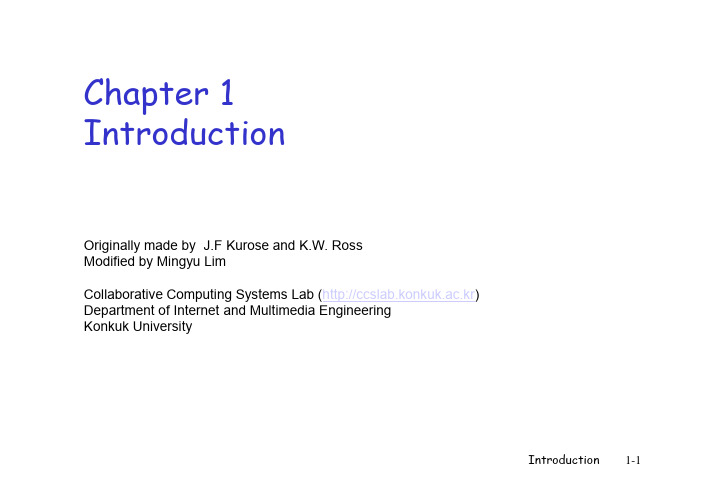
Chapter 1IntroductionOriginally made by J.F Kurose and K.W. RossModified by Mingyu LimCollaborative Computing Systems Lab (http://ccslab.konkuk.ac.kr) Department of Internet and Multimedia EngineeringKonkuk UniversityChapter 1: roadmap1.1 What is the Internet?1.2Network edgeend systems, access networks, links1.3Network corecircuit switching, packet switching, network structure1.4Delay, loss and throughput in packet-switchednetworks1.5Protocol layers, service models1.6Networks under attack: security1.7HistoryGlobal ISP Home network“Cool” internet appliancesIP picture frame/Web-enabled toaster +weather forecasterWorld’s smallest web server/~shri/iPic.htmlInternet phonesGlobal ISP Home networkWhat’s a protocol?a human protocol and a computer network protocol:Hi TCP connection request Q:Other human protocols?HiGot the time?2:00TCP connection responseGet /kurose-ross<file>timeChapter 1: roadmap1.1 What is the Internet?1.2 Network edgeend systems, access networks, links1.3 Network corecircuit switching, packet switching, network structure1.4Delay, loss and throughput in packet-switchednetworks1.5Protocol layers, service models1.6Networks under attack: security1.7HistoryAccess networks and physical media Q: How to connect endsystems to edge router?residential access netsinstitutional accessnetworks (school,company)mobile access networksKeep in mind:bandwidth (bits persecond) of accessnetwork?shared or dedicated?Residential access: point to point accessDialup via modemup to 56Kbps direct access torouter (often less)Can’t surf and phone at sametime: can’t be “always on”DSL:digital subscriber linedeployment: telephone company (typically)up to 1 Mbps upstream (today typically < 256 kbps) up to 8 Mbps downstream (today typically < 1 Mbps) dedicated physical line to telephone central officeResidential access: cable modemsHFC: hybrid fiber coaxasymmetric: up to 30Mbps downstream, 2Mbps upstreamnetwork of cable and fiber attaches homes to ISP routerhomes share access to routerdeployment: available via cable TV companiesResidential access: cable modemsCable Network Architecture: Overviewhomecable headendcable distributionnetwork (simplified)Typically 500 to 5,000 homesCable Network Architecture: Overviewserver(s)homecable headendcable distribution networkCable Network Architecture: Overviewhomecable headendcable distributionnetwork (simplified)Cable Network Architecture: OverviewV I D E O V I D E O V I D E O V I D E O V I D E O V I D E O D A T A D A T A CONTROL123456789FDM (more shortly):homecable headendcable distribution networkChannelsCompany access: local area networkscompany/univ local areanetwork(LAN) connectsend system to edge routerEthernet:10 Mbs, 100Mbps,1Gbps, 10Gbps Ethernetmodern configuration:end systems connectinto Ethernet switchLANs: chapter 5Wireless access networks shared wireless accessnetwork connects end systemto routervia base station aka “accesspoint”wireless LANs:base router802.11b/g (WiFi): 11 or 54 Mbps wider-area wireless access provided by telco operator~1Mbps over cellular system(EVDO, HSDPA)next up (?): WiMAX (10’s Mbps) over wide area stationmobilehostsHome networksTypical home network components: DSL or cable modem router/firewall/NAT Ethernetwireless access wireless access pointwireless access pointwireless laptopsrouter/firewallcable modemto/from cable headendEthernetPhysical Media: coax, fiberCoaxial cable:two concentric copper conductorsbidirectionalbaseband:single channel on cable Fiber optic cable:glass fiber carrying light pulses, each pulse a bithigh-speed operation:high-speed point-to-point single channel on cablelegacy Ethernetbroadband:multiple channels oncableHFCtransmission (e.g., 10’s-100’s Gps)low error rate: repeatersspaced far apart ; immuneto electromagnetic noisePhysical media: radiosignal carried in electromagneticspectrumno physical “wire” bidirectional Radio link types:terrestrial microwavee.g. up to 45 Mbps channels LAN(e.g., Wifi)11Mbps, 54 Mbpswide-area(e.g., cellular)propagationenvironment effects:reflectionobstruction by objectsinterference wide-area(e.g., cellular) 3G cellular: ~ 1 MbpssatelliteKbps to 45Mbps channel (or multiple smaller channels) 270 msec end-end delaygeosynchronous versus low altitudeChapter 1: roadmap1.1 What is the Internet?1.2Network edgeend systems, access networks, links1.3 Network corecircuit switching, packet switching, network structure1.4Delay, loss and throughput in packet-switchednetworks1.5Protocol layers, service models1.6Networks under attack: security1.7HistoryThe Network Core mesh of interconnectedroutersthe fundamentalquestion:how is datatransferred through net?circuit switching:dedicated circuit percall: telephone netpacket-switching:datasent thru net indiscrete “chunks”Network Core: Circuit Switchingnetwork resources (e.g., bandwidth) divided into “pieces” pieces allocated to calls dividing link bandwidth into “pieces”frequency divisiontime divisionresource piece idle if not used by owning call (no sharing)Circuit Switching: FDM and TDMFDMfrequency4 usersExample: timeTDMfrequencytimeNumerical exampleHow long does it take to send a file of 640,000 bits from host A to host B over a circuit-switched network?All links are 1.536 MbpsEach link uses TDM with 24 slots/secEach link uses TDM with 24 slots/sec500 msec to establish end-to-end circuit Let’s work it out!Network Core: Packet Switchingeach end-end data stream divided into packetsuser A, B packets share network resourceseach packet uses full link resource contention: aggregate resource demand can exceedamount availablecongestion: packetsbandwidthresources used as neededqueue, wait for link use store and forward: packets move one hopat a timeNode receives completepacket before forwardingBandwidth division into “pieces”Dedicated allocationResource reservationPacket Switching: Statistical MultiplexingA BC100 Mb/s Ethernet1.5 Mb/sstatistical multiplexingqueue of packets Sequence of A & B packets does not have fixed pattern, bandwidth shared on demand statistical multiplexing .TDM: each host gets same slot in revolving TDM frame.DEwaiting for outputlinkPacket-switching: store-and-forwardtakes L/R seconds to transmit (push out)packet of L bits on to Example:L = 7.5 MbitsR R R Llink at R bpsstore and forward:entire packet mustarrive at router before it can be transmittedon next linkdelay = 3L/R (assuming zero propagation delay) R = 1.5 Mbpstransmission delay = 15 secmore on delay shortly …Packet switching versus circuit switching1 Mb/s linkeach user:100 kb/s when “active”Packet switching allows more users to use network!active 10% of time circuit-switching:10 userspacket switching:with 35 users,probability > 10 active at same time is less than .0004N users1 Mbps linkQ: how did we get value 0.0004?Packet switching versus circuit switching Is packet switching a “slam dunk winner?”great for bursty dataresource sharingsimpler, no call setupexcessive congestion:packet delay and lossprotocols needed for reliable data transfer,congestion controlQ: How to provide circuit-like behavior?bandwidth guarantees needed for audio/video apps still an unsolved problem (chapter 7)Q: human analogies of reserved resources (circuitswitching) versus on-demand allocation (packet-switching)?Internet structure: network of networksroughly hierarchicalat center: “tier-1” ISPs (e.g., Verizon, Sprint, AT&T,Cable and Wireless), national/international coverage treat each other as equalsTier 1 ISPTier 1 ISPTier 1 ISPTier-1 providers interconnect (peer) privatelyTier-1 ISP: e.g., Sprint…peeringto/from backbone…POP: point-of-presenceto/from customers.………Internet structure: network of networks“Tier-2” ISPs: smaller (often regional) ISPsConnect to one or more tier-1 ISPs, possibly other tier-2 ISPsTier-2 ISPs Tier 1 ISPTier 1 ISPTier 1 ISPTier-2 ISPTier-2 ISPTier-2 ISPTier-2 ISPTier-2 ISPTier-2 ISP pays tier-1 ISP for connectivity to rest of Internet tier-2 ISP is c ustomer of tier-1 provideralso peerprivately with each other.Internet structure: network of networks“Tier-3” ISPs and local ISPslast hop (“access”) network (closest to end systems)local ISPlocal local local ISPTier 3ISP Local and tier-Tier 1 ISPTier 1 ISPTier 1 ISPTier-2 ISPTier-2 ISPTier-2 ISP Tier-2 ISP Tier-2 ISPISPISPlocal ISP local ISPlocal ISPlocal ISP3 ISPs are customers of higher tier ISPsconnecting them to rest of InternetInternet structure: network of networksa packet passes through many networks!local ISPlocal local local ISPTier 3ISP Tier 1 ISPTier 1 ISPTier 1 ISPTier-2 ISPTier-2 ISPTier-2 ISP Tier-2 ISPTier-2 ISPISPISPlocal ISP local ISPlocal ISPlocal ISPChapter 1: roadmap1.1 What is the Internet?1.2Network edgeend systems, access networks, links1.3Network corecircuit switching, packet switching, network structure1.4 Delay, loss and throughput in packet-switchednetworks1.5Protocol layers, service models1.6Networks under attack: security1.7HistoryHow do loss and delay occur?packets queue in router bufferspacket arrival rate to link exceeds output link capacitypackets queue, wait for turnpacket being transmitted (delay) ABpackets queueing(delay)free (available) buffers: arriving packetsdropped (loss) if no free buffersFour sources of packet delay1. nodal processing:check bit errorsdetermine output link 2. queueingtime waiting at output link for transmission depends on congestion level of routerA Bpropagation transmissionnodalprocessing queueingDelay in packet-switched networks3. Transmission delay:R=link bandwidth (bps) L=packet length (bits) time to send bits into 4. Propagation delay:d = length of physical links = propagation speed in medium (~2x108m/sec) propagation delay = d/slink = L/R propagation delay = d/sA Bpropagationtransmissionnodalprocessing queueingNote: s and R are verydifferent quantities!cars “propagate” atTime to “push” entirecaravan through toll toll boothtoll boothCars now “propagate” atAfter 7 min, 1st carat 2nd booth and 3 cars toll boothtoll boothNodal delayd proc = processing delaytypically a few microsecs or less d proptrans queue proc nodal d d d d d +++= d queue = queuing delay depends on congestiond trans = transmission delay= L/R, significant for low-speed links d prop = propagation delaya few microsecs to hundreds of msecsQueueing delay (revisited)R=link bandwidth (bps)L=packet length (bits)a=average packetarrival ratetraffic intensity = La/RLa/R ~ 0: average queueing delay smallLa/R -> 1: delays become largeLa/R > 1: more “work” arriving than can be serviced, average delay infinite!。
数据通信英语作文

数据通信英语作文Nowadays, data communication has become an essential part of our daily lives. Nowadays, data communication has become an essential part of our daily lives. (如今,数据通信已经成为我们日常生活的一个重要组成部分。
The importance of data communication can be seen in various aspects of our lives, from the way we interact with our loved ones to the way businesses operate. 数据通信的重要性在我们生活的各个方面都可以看到,从我们与亲人互动的方式到企业运营的方式。
In our personal lives, data communication allows us to stay connected with our friends and family no matter where they are in the world. 在我们的个人生活中,数据通信让我们能够与朋友和家人保持联系,无论他们身在何处。
Through social media platforms, instant messaging apps, and video calls, we are able to share our experiences, emotions, and memories with the people we care about, bridging the physical distancesbetween us. 通过社交媒体平台、即时通讯应用和视频通话,我们能够与我们关心的人分享我们的经历、情感和回忆,弥合我们之间的物理距离。
Lecture1-Introduction
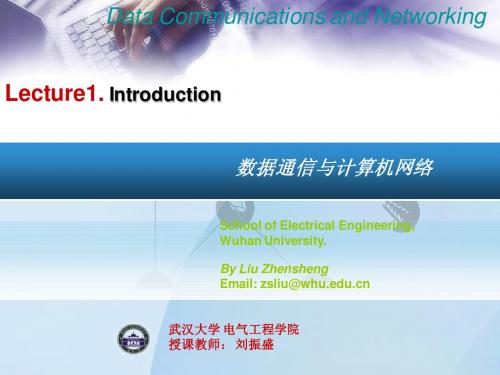
hybrid topology in fact
1.2.3 Network Criteria(网络指标 网络指标) 网络指标
Data communications and networking
Performance Transit time Response time: elapsed time between an inquiry and the response Throughput (吞吐量 ) 吞吐量) 吞吐量 Reliability Accuracy of delivery (error bit ratio) Frequency of failures and recovery time(恢复时间) after a failure Robustness in a catastrophe(大灾难) 大灾难) Security Unauthorized access (未授权访问) Viruses infection(病毒 病毒) 病毒
1.2 What is Data Communication Networks 1.2.1 Distributed System and Network Distributed system (分布式系统 分布式系统) 分布式系统 multiple computers complete the same task collaborati-vely ,each separate computer handling a subset Key: handling respectively Communication network (通信网络 通信网络) 通信网络 Concept: point to point point to multi-point multi-point to multi-point Communication network is made of a lot of links(链路 链路) 链路 and Nodes(节点 sharing and exchanging information 节点), 节点 Key: information sharing and exchanging
Communications and Networks
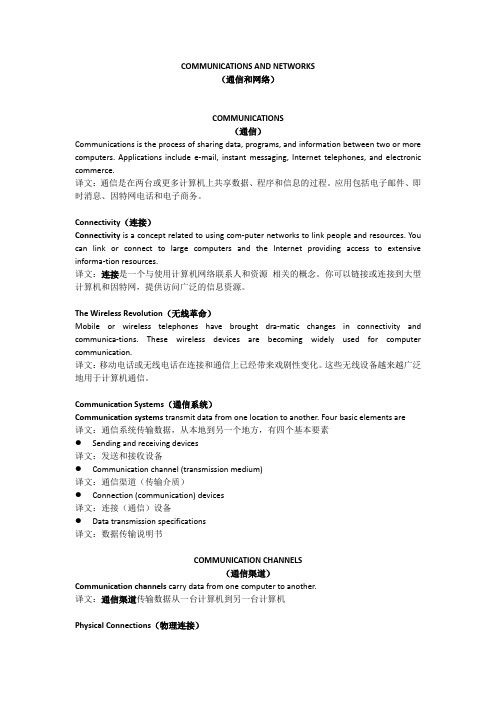
COMMUNICATIONS AND NETWORKS(通信和网络)COMMUNICATIONS(通信)Communications is the process of sharing data, programs, and information between two or more computers. Applications include e-mail, instant messaging, Internet telephones, and electronic commerce.译文:通信是在两台或更多计算机上共享数据、程序和信息的过程。
应用包括电子邮件、即时消息、因特网电话和电子商务。
Connectivity(连接)Connectivity is a concept related to using com-puter networks to link people and resources. You can link or connect to large computers and the Internet providing access to extensive informa-tion resources.译文:连接是一个与使用计算机网络联系人和资源相关的概念。
你可以链接或连接到大型计算机和因特网,提供访问广泛的信息资源。
The Wireless Revolution(无线革命)Mobile or wireless telephones have brought dra-matic changes in connectivity and communica-tions. These wireless devices are becoming widely used for computer communication.译文:移动电话或无线电话在连接和通信上已经带来戏剧性变化。
OTN基本原理详解

1.3 OTN相关标准
• OTN的相关标准
• 框架 • 体系架构 • 结构和映射 • 设备功能特征 • 性能 • 物理层 • 设备管理特性 • 保护
G.871 G.872 G.709 G.798
G.8201,G.8251 G.664,G.693,G.959.1 G.874,G.874.1,G.875,G.7710 G.873.1
1 FA OH OTUk OH
2
OPUk
3 ODUk OH OH
4
……
3824
OPUk Payload
OCI: Open Connection Indication PMI: Payload Missing Indication TTI: Trail Trace Identifier
2.2 OTM:光传送模块
• 全功能OTM和简化OTM区别
• 简化信号结构中不需OSC/OOS(光传送模块开销信号) • 未定义OPS(光物理段)开销,直接在接口位置使用OTUk[V]
SMOH进行监控和管理。
• OTUk、OTUkV和OTUkv的区别
• OTUk帧结构,包括OTUk FEC,已完全标准化 • OTUkV帧结构,包括OTUk FEC,二者仅功能标准化(仅指定了必
须的功能) • OTUkv,将完全标准化的OTUk帧结构与部分标准化的OTUkV FEC
结合。
2.2 OTM:光传送模块
2.OTN网络层次结构
• 1. OTN概述 • 2. OTN网络层次结构 • 3. OTN帧结构 • 4. OTN的映射和复用 • 5. OTN的保护
2.OTN网络层次结构
OCh substructure
• 全功能OTM和 简化OTM
Communication Systems and Networks
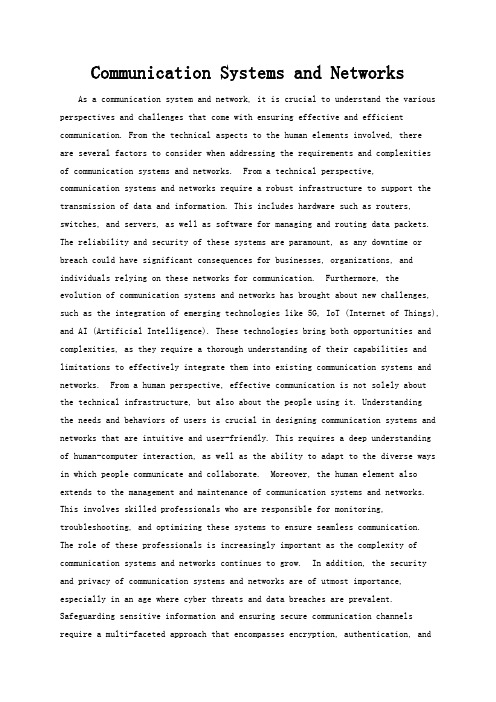
Communication Systems and Networks As a communication system and network, it is crucial to understand the various perspectives and challenges that come with ensuring effective and efficient communication. From the technical aspects to the human elements involved, thereare several factors to consider when addressing the requirements and complexities of communication systems and networks. From a technical perspective, communication systems and networks require a robust infrastructure to support the transmission of data and information. This includes hardware such as routers, switches, and servers, as well as software for managing and routing data packets. The reliability and security of these systems are paramount, as any downtime or breach could have significant consequences for businesses, organizations, and individuals relying on these networks for communication. Furthermore, the evolution of communication systems and networks has brought about new challenges, such as the integration of emerging technologies like 5G, IoT (Internet of Things), and AI (Artificial Intelligence). These technologies bring both opportunities and complexities, as they require a thorough understanding of their capabilities and limitations to effectively integrate them into existing communication systems and networks. From a human perspective, effective communication is not solely about the technical infrastructure, but also about the people using it. Understandingthe needs and behaviors of users is crucial in designing communication systems and networks that are intuitive and user-friendly. This requires a deep understanding of human-computer interaction, as well as the ability to adapt to the diverse ways in which people communicate and collaborate. Moreover, the human element also extends to the management and maintenance of communication systems and networks. This involves skilled professionals who are responsible for monitoring, troubleshooting, and optimizing these systems to ensure seamless communication. The role of these professionals is increasingly important as the complexity of communication systems and networks continues to grow. In addition, the security and privacy of communication systems and networks are of utmost importance, especially in an age where cyber threats and data breaches are prevalent. Safeguarding sensitive information and ensuring secure communication channels require a multi-faceted approach that encompasses encryption, authentication, andconstant vigilance against potential threats. From a business perspective, communication systems and networks are integral to the operations and success of organizations. Whether it's internal communication among employees or external communication with clients and partners, the efficiency and reliability of these systems directly impact productivity and the overall bottom line. As such, businesses must invest in robust communication systems and networks that can scale with their growth and adapt to changing needs. Furthermore, the global nature of business today requires communication systems and networks that can facilitate seamless communication across borders and time zones. This necessitates an understanding of international regulations and standards, as well as the ability to overcome language and cultural barriers in communication. In conclusion, communication systems and networks are complex and multifaceted, requiring a holistic approach that addresses technical, human, and business perspectives. By understanding and integrating these perspectives, we can ensure that communication systems and networks are not only reliable and secure but also intuitive and adaptable to the evolving needs of users and organizations.。
介绍通信网学科的英语作文

介绍通信网学科的英语作文【中英文版】Introduction to the Discipline of Telecommunication Networks通信网学科是一门集成了电子工程、计算机科学以及信息技术等多个领域的研究科目。
It encompasses the study and application of various technologies and methods for the transmission, reception, and processing of information over distances.This interdisciplinary field has seen rapid development in recent years, largely due to the surge in global digitalization and the increasing reliance on communication networks.在当今数字化时代,通信网络的重要性不言而喻。
无论是手机通讯、互联网数据传输还是物联网技术,通信网络都扮演着核心角色。
The discipline of telecommunication networks not only focuses on the fundamental principles of signal transmission but also delves into the design, implementation, and management of complex network infrastructures.Students pursuing this discipline are exposed to a wide array of topics, including network protocols, data encryption, wireless communication, and network architecture.These topics are crucial in understanding the intricacies of modern communication systems and are essential for developing innovative solutions to contemporary communication challenges.学习通信网学科的学生将会接触到众多关键议题,如网络协议、数据加密、无线通讯和网络架构等。
InternationalJournalofSensorNetworksandData...
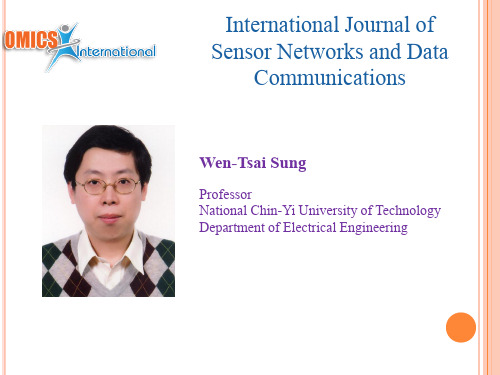
3.
Editor-in-Chief,-Journal of Vibration Analysis, Measurement, and
Control (JVAMC)
International Journal of Sensor Networks and Data Communications
4. Guest Editor- IET Systems Biology 5. Associate-Editor -International Journal of Sensor Networks and Data Communications (IJSNDC) 6. Associate-Editor -BIOINFO Sensor Networks 7. Editors-International Journal of Digital Content Technology and its Applications (JDCTA) 8. Editor -International Journal of Artificial Intelligence and Expert Systems (IJAE) 9. Editor -Scientific Journal of Computer Science (IJAE) 10. Editor -Application of Information and Communication Technology (AICT) 11. Editor -International Journal of Communications (IJC)
International Journal of Sensor Networks and Data Communications
1.Serve as the keynote speech recently: 2013 3rd International Conference on Applied Mechanics, Materials and Manufacturing (ICA3M 2013), 24-25, August, Dalian, China
- 1、下载文档前请自行甄别文档内容的完整性,平台不提供额外的编辑、内容补充、找答案等附加服务。
- 2、"仅部分预览"的文档,不可在线预览部分如存在完整性等问题,可反馈申请退款(可完整预览的文档不适用该条件!)。
- 3、如文档侵犯您的权益,请联系客服反馈,我们会尽快为您处理(人工客服工作时间:9:00-18:30)。
Chapter 03Basics of AudioB i f A diOutline3.1 Digitization of Sound31i i i i f S d3.2 MIDI: Musical Instrument Digital32MIDI:Musical Instrument DigitalInterface3.1Digitization of Sound3.1 Digitization of SoundWhat is Sound?Sound is a wave phenomenon like light, but is macroscopic and involves molecules of air being compressed and expanded under the action ofsome physical devicesome physical device.(a) For example, a speaker in an audio system vibrates back and forth andproduces a longitudinal pressure wave that we perceive as sound.(b) Since sound is a pressure wave, it takes on continuous values, as opposed todigitized ones.(c) Even though such pressure waves are longitudinal, they still have ordinarywave properties and behaviors, such as reflection (bouncing), refraction(g g g y)(change of angle when entering a medium with a different density) anddiffraction (bending around an obstacle).(d) If we wish to use a digital version of sound waves we must form digitizedprepresentations of audio information.gDigitizationDigitization means conversion to a stream of numbers, and preferablyh b h ld b i f ffi ithese numbers should be integers for efficiency.Fig. 3.1 shows the 1-dimensional nature of sound: amplitude values p,depend on a 1D variable, time.3.1The graph in Fig. 3.1 has to be made digital in both time and amplitude. To digitize, the signal must be sampled in each dimension: in time, and in amplitude.(a) Sampling means measuring the quantity we are interested in, usually at evenly-spaced intervals.(b) The first kind of sampling, using measurements only at evenly spaced time(b)The first kind of sampling using measurements only at evenly spaced timeintervals, is simply called, sampling. The rate at which it is performed is called the sampling frequency (see Fig. 3.2(a)).(c) For audio, typical sampling rates are from 8 kHz (8,000 samples per second) to(c)For audio typical sampling rates are from8kHz(8000samples per second)to48 kHz. This range is determined by Nyquist theorem discussed later.(d) Sampling in the amplitude or voltage dimension is called quantization. Fig.3.2(b) shows this kind of sampling.32(b)h thi ki d f li3.2Thus to decide how to digitize audio data we need to answer the following questions:1. What is the sampling rate?1What is the sampling rate?2. How finely is the data to be quantized, and is quantization uniform?3. How is audio data formatted? (file format)()3.2 MIDI: Musical Instrument3.MI I Musical Instrument Digital InterfaceUse the sound card's defaults for sounds: → use a simple scripting language and hardware setup called MIDI.MIDI Overview(a) MIDI is a scripting language ㅡit codes “events" that stand for the productionof sounds. e.g., a MIDI event might include values for the pitch of a single note,f d MIDI t i ht i l d l f th it h f i l tits duration, and its volume.(b) MIDI is a standard adopted by the electronic music industry for controllingdevices, such as synthesizers and sound cards, that produce music.d i h h i d d d h d i(c) The MIDI standard is supported by most synthesizers, so sounds created on onesynthesizer can be played and manipulated on another synthesizer and soundreasonably close.(d) Computers must have a special MIDI interface, but this is incorporated intomost sound cards. The sound card must also have both D/A and A/D converters.pMIDI ConceptsMIDI channels are used to separate messages.(a) There are 16 channels numbered from 0 to 15. The channel forms the last 4bits (the least significant bits) of the message.(b) Usually a channel is associated with a particular instrument: e.g., channel 1 (b)Usually a channel is associated with a particular instrument:e g channel1is the piano, channel 10 is the drums, etc.(c) Nevertheless, one can switch instruments midstream, if desired, andassociate another instrument with any channel.i t th i t t ith h lSystem messages(a) Several other types of messages, e.g. a general message for all instrumentsindicating a change in tuning or timing.indicating a change in t ning or timing(b) If the first 4 bits are all 1s, then the message is interpreted as a system commonmessage.The way a synthetic musical instrument responds to a MIDI message is usually by simply ignoring any play sound message message is usually by simply ignoring any play sound messagethat is not for its channel.-If several messages are for its channel, then the instrument responds, provided it is g,p,p multi-voice, i.e., can play more than a single note at once.i f h i i h h i bIt is easy to confuse the term voice with the term timbre ㅡthe latter is MIDI terminology for just what instrument that is t i t b l t d i d t i li it i trying to be emulated, e.g. a piano as opposed to a violin: it is the quality of the sound.(a) An instrument (or sound card) that is multi-timbral is one that is capable of(a)An instrument(or sound card)that is multi timbral is one that is capable ofplaying many different sounds at the same time, e.g., piano, brass, drums, etc.(b) On the other hand, the term voice, while sometimes used by musicians to meanthe same thing as timbre, is used in MIDI to mean every different timbre andpitch that the tone module can produce at the same time.Different timbres are produced digitally by using a patch ㅡthe set of control settings that define a particular timbre.the set of control settings that define a particular timbrePatches are often organized into databases, called banks.General MIDI: A standard mapping specifying what instruments (what patches) will be associated with what channels.h l(a) In General MIDI, channel 10 is reserved for percussion instruments, and(a)In General MIDI,channel10is reserved for percussion instruments,andthere are 128 patches associated with standard instruments.(b) For most instruments, a typical message might be a Note On message(meaning, e.g., a keypress and release), consisting of what channel, what(meaning e g a keypress and release)consisting of what channel whatpitch, and what " velocity" (i.e., volume).(c) For percussion instruments, however, the pitch data means which kind ofdrum.drum(d) A Note On message consists of " status" byte which channel, what pitch ㅡfollowed by two data bytes. It is followed by a Note O message, which also has a pitch (which note to turn o) and a velocity (often set to zero).has a pitch(which note to turn o)and a velocity(often set to zero)Hardware Aspects of MIDI Hardware Aspects of MIDI3.33.3The physical MIDI ports consist of 5-pin connectors for IN and OUT, as well as a third connector called THRU.(a) MIDI communication is half-duplex.(b) MIDI IN is the connector via which the device receives all MIDI data.(c) MIDI OUT is the connector through which the device transmits all the MIDIdata it generates itself.(d) MIDI THRU is the connector by which the device echoes the data it receivesfrom MIDI IN. Note that it is only the MIDI IN data that is echoed by MIDI THRU -all the data generated by the device itself is sent via MIDI OUT.3.43.434Chapter 04 Fundamental Concepts F d t l C t in Videoin VideoOutline4.1 Analog Video41Analog Video4.2 Digital Video4.1 Analog VideoAn analog signal f(t) samples a time-varying image. So-called “progressive"scanning traces through a complete picture (a frame)row g“progressive" scanning traces through a complete picture (a frame) row-wise for each time interval. In TV, and in some monitors and multimedia standards as well, another system, called “interlaced" scanning is used:a) The odd-numbered lines are traced rst, and then the even-numbered lines are )traced. This results in “odd" and “even" fields -two fields make up one frame.b) In fact, the odd lines (starting from 1) end up at the middle of a line at the end of the odd field, and the even scan starts at a half-way point.,y pc) Figure 4.1 shows the scheme used. First the solid (odd) lines are traced, P to Q, then R to S, etc., ending at T; then the even field starts at U and ends at V.d)The jump from Q to R etc in Figure 41is called the horizontal retrace during d) The jump from Q to R, etc. in Figure 4.1 is called the horizontal retrace, during which the electronic beam in the CRT is blanked. The jump from T to U or V to P is called the vertical retrace.4.1Because of interlacing, the odd and even lines are displaced in time from each other | generally not noticeable except when very fast action is taking place on screen, when blurring may occur.place on screen when blurring may occurFor example, in the video in Fig. 4.2, the moving helicopter is blurred more than is the still background.4.24.2 Digital Video4.2Digital VideoThe advantages of digital representation for video are many The advantages of digital representation for video are many.For example:(a) Video can be stored on digital devices or in memory, ready to be processed(noise removal, cut and paste, etc.), and integrated to various multimediaapplications;(b) Direct access is possible, which makes nonlinear video editing achievable as asimple, rather than a complex, task;(c) Repeated recording does not degrade image quality;()p g g g q y;(d) Ease of encryption and better tolerance to channel noise.Chroma SubsamplingSince humans see color with much less spatial resolution than they see black and ,gwhite, it makes sense to “decimate" the chrominance signal.To begin with, numbers are given stating how many pixel values, per four original pixels, are actually sent:The chroma scheme\4:4:4"indicates that no chroma is(a)The chroma subsampling scheme \4:4:4 indicates that no chroma subsampling isused: each pixel's Y, Cb and Cr values are transmitted, 4 for each of Y, Cb, Cr.(b)The scheme \4:2:2" indicates horizontal subsampling of the Cb, Cr signals by afactor of2That is of four pixels horizontally labelled as0to3all four Ys arefactor of 2. That is, of four pixels horizontally labelled as 0 to 3, all four Ys aresent, and every two Cb's and two Cr's are sent, as (Cb0, Y0)(Cr0,Y1)(Cb2,Y2)(Cr2, Y3)(Cb4, Y4), and so on (or averaging is used).The scheme\4:1:1"subsamples horizontally by a factor of4(c)The scheme \4:1:1" subsamples horizontally by a factor of 4.(d)The scheme \4:2:0" subsamples in both the horizontal and vertical dimensions bya factor of 2. Theoretically, an average chroma pixel is positioned between therows and columns as shown Fig.4.3.d l h Fi434.3HDTV (High Definition TV)The main thrust of HDTV (High Definition TV) is not to (g )increase the “definition" in each unit area, but rather to increase the visual field especially in its width.(a) The first generation of HDTV was based on an analog technology developed by Sony and NHK in Japan in the late 1970s.(b) MUSE (Multiple sub-Nyquist Sampling Encoding) was an improved NHK HDTV with hybrid analog/digital technologies that was put in use in the 1990s. It has 1,125 scan lines, interlaced (60 fields per second), and 16:9 aspect ratio.,,(p ),p(c) Since uncompressed HDTV will easily demand more than 20 MHz bandwidth, which will not t in the current 6 MHz or 8 MHz channels, various compression techniques are being investigated.q g g(d) It is also anticipated that high quality HDTV signals will be transmitted using more than one channel even after compression.A brief history of HDTV evolution:A brief history of HDTV evolution:(a) In 1987, the FCC decided that HDTV standards must be compatible with theexisting NTSC standard and be conned to the existing VHF (Very HighFrequency) and UHF (Ultra High Frequency) bands.(),y,,p(b) In 1990, the FCC announced a very different initiative, i.e., its preference for afull-resolution HDTV, and it was decided that HDTV would be simultaneously broadcast with the existing NTSC TV and eventually replace it.()g p p g,y(c) Witnessing a boom of proposals for digital HDTV, the FCC made a key decisionto go all-digital in 1993. A “grand alliance" was formed that included four main proposals, by General Instruments, MIT, Zenith, and AT&T, and by Thomson, pPhilips, Sarno and others.(d) This eventually led to the formation of the ATSC (Advanced TelevisionSystems Committee) | responsible for the standard for TV broadcasting ofHDTV.(e) In 1995 the U.S. FCC Advisory Committee on Advanced Television Servicerecommended that the ATSC Digital Television Standard be adopted.。
